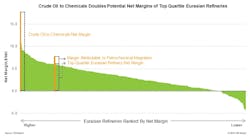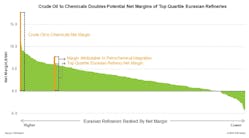Crude oil-to-chemicals (COTC), a new chemical process technology, could more than double the profitability derived from a barrel of crude oil, according to IHS Markit.
Based on IHS Markit’s analysis, global, integrated refining and petrochemical companies currently earn about $8.50/bbl of refined crude oil. By leveraging the COTC process technology (based on a Saudi Aramco Technologies COTC design) in a world-scale refining and chemical facility, owners could increase their plant net margins to $17/bbl, according to findings published in IHS Markit’s economic assessment.
Transformative and timely
“This process is both transformative in terms of its potential, and timely, as refiners face declining future demand for gasoline and fuel production due to carbon emission mandates, greater vehicle fuel efficiency, and an increasing penetration of electric vehicles,” said Don Bari, vice-president of chemical technology at IHS Markit, and an author of the report along with Michael Arne, executive director, emerging technologies research, at IHS Markit.
Global chemicals demand is rising at a higher rate than fuel demand, Bari said, so the desire to produce higher-value chemicals from lower-value feedstocks like crude and ethane is driving tremendous interest in these disruptive technologies. One of the most disruptive technologies or categories of technologies being developed, based on their sheer volume, is COTC, Bari said. These projects fuse a refinery and petrochemical plant together in a fundamentally new way, he said.
“This goes well beyond the state-of-the-art refinery petrochemical integration by implementing new reconfigured unit operations into a refinery,” Bari said. “The objective is to shift the product slate derived from a barrel of oil to a range of 60-80% chemical production and nonfuel products, up from the traditional range of 10-15% or so, in order to significantly increase the value of crude oil reserves and provide demand security in Aramco’s case. This transformative COTC technology goes beyond even the most ‘highly’ integrated sites today that are pushing 30-40% chemicals production with traditional approaches,” Bari said.
IHS Markit embarked on the analysis of the economic potential of the COTC technology following the 2018 announcement by Siluria Technologies that it had joined forces with Saudi Aramco Technologies. Following the 2018 announcement, Bari said the Siluria Technologies process, which produces olefins directly from natural gas through oxidative coupling (chemistry) of methane (OCM), is expected to further allow Aramco’s future COTC facilities to create more value by converting very low-value off-gases (largely methane) into higher-value olefins products, which improves carbon efficiency and increases the volume of the barrel of oil directed to valuable fundamental petrochemicals.
Disruptive technology
COTC technologies are potentially so disruptive to the industry’s current processes and capabilities, Arne said, and are even more intriguing considering Aramco’s acquisition of a 70% controlling stake in Saudi Arabia Basic Industries Co. (SABIC). The deal combines the world’s largest oil producer by volume (13.6 million b/d of crude and condensate in 2018), with the world’s fifth-largest chemical company by sales, according to IHS Chemical Week. In addition to the deal, Aramco has committed to invest $100 billion in petrochemicals through 2030.
Aramco plans to increase its global refining capacity to 8-10 million b/d of oil from 4.9 million b/d by 2030. “If you consider that of the increased refining capacity Aramco proposes, 2-3 million b/d will be used to produce chemicals, the potential additions to the global chemical balance are quite extraordinary to contemplate,” Bari said.
In its current analysis of the COTC technologies, IHS Markit assessed just the potential economics of the Aramco COTC process because of its near-term viability at scale. The Siluria process is too early in its development for IHS Markit to model economics, Bari said. The assessment, however, did take the OCM process into consideration for purposes of discussing increased yields through integration.
IHS Markit’s refined products balances demonstrate the necessity for higher levels of petrochemical integration as the two largest refined products, gasoline and diesel-gas oil, reach global peak demand in the mid-2030s, but refinery-derived petrochemical feedstocks continue growing beyond 2050 even as global crude runs decline. Deeper refining-petrochemical integration—including COTC as it’s proven commercially—is an essential part of IHS Markit’s outlook, particularly in certain Middle East and Asian hubs, Bari said.
“The IHS Markit COTC process concept illustrates why so many companies are interested in this technology,” Bari said. “Our base case shows a 48% yield to prime olefins,” he said. “On a third-quarter 2018 Saudi basis, the refinery margin is $17/bbl EBITDA and $12/bbl EBIT for a high performing (though small) refinery of 200,000 b/d compared with $7/bbl to $10/bbl EBITDA for top-quartile Euroasia refineries.”
According to the IHS Markit analysis, the COTC process affords the refiner-petrochemical producer sustainability gains through the reduction in the overall carbon footprint of a facility due to integration and optimization of assets, which become more efficient.



